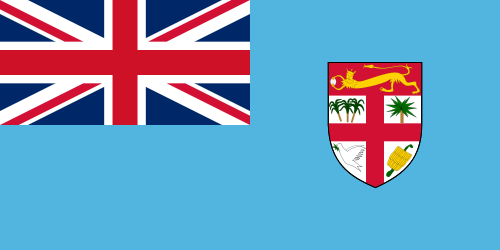
Country Flags by Continent
|
|
Prior to ceding the country to British rule in 1874, the government of Fiji adopted a national flag featuring blue and white vertical stripes, with in the centre a red shield depicting a white dove.This flag ceased to be used when the colonial era began and Fiji relinquished its independence. Fiji was a British colony from 1874 to 1970.
The current flag of Fiji was adopted on October 10, 1970. The state arms have been slightly modified but the flag has remained the same as during the colonial period. It is a defaced sky-blue "Blue Ensign" (the actual Blue Ensign version of the flag is the Government ensign). It has remained unchanged since Fiji was declared a republic in 1987, despite calls from some politicians (such as Opposition Senator Atu Emberson-Bain) for changes.
Its bright blue background symbolizes the Pacific Ocean, which plays an important part in the lives of the islanders, both in terms of the fishing industry, and the huge tourist trade. The Union Jack reflects the country's links with Great Britain. The shield is derived from the country's official coat of arms, which was originally granted by Royal Warrant in 1908. It is a white shield with a red cross and a red chief (upper third of a shield). The images depicted on the shield represent agricultural activities on the islands, and the historical associations with Great Britain. At the top of the shield, a British lion holds a cocoa pod between its paws. The upper left is sugar cane, upper right is a coconut palm, the lower left a dove of peace, and the lower right a bunch of bananas.
The current flag is very similar to the colonial ensign used prior to independence, the main differences being the latter used a darker shade of blue and displayed the entire Fijian coat of arms as opposed to just the shield. While some reformists have called for the removal of the Union Flag, seeing it a British colonial emblem, others support its retention for the sake of historical continuity. The flags of other independent countries, such as Australia, New Zealand and Tuvalu retain the Union Flag in their national flags.
Some influential Fijians have called for the restoration of the full coat of arms to the flag. On November 30, 2005, Fiji's Great Council of Chiefs called for the two warrior figures, who guard the shield on the coat of arms, to be placed on the flag, along with a miniature canoe and the national motto, Rerevaka na kalou ka doka na tui ("Fear God and honour the queen") — symbols that were featured on the original flag of the Kingdom of Viti, the first unified Fijian state, forged by Seru Epenisa Cakobau in 1871.
"The coat of arms is very significant because it has the word of God, then it has the two warriors and the Fijian canoe also. I think that the council members prefer that the full coat of arms be included in the Fiji flag," said Asesela Sadole, General Secretary of the Great Council of Chiefs. |

